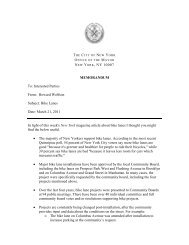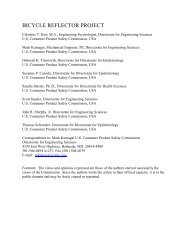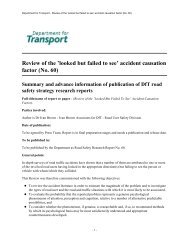Guide for the Development of Bicycle Facilities - The Industrialized ...
Guide for the Development of Bicycle Facilities - The Industrialized ...
Guide for the Development of Bicycle Facilities - The Industrialized ...
You also want an ePaper? Increase the reach of your titles
YUMPU automatically turns print PDFs into web optimized ePapers that Google loves.
guide <strong>for</strong> <strong>the</strong> development <strong>of</strong> bicycle facilities 23<br />
Bike lanes should never be placed between <strong>the</strong> parking lane and curb<br />
lane. Bike lanes between <strong>the</strong> curb and parking lane can create obstacles<br />
<strong>for</strong> bicyclists from opening car doors and poor visibility at intersections<br />
and driveways and <strong>the</strong>y prohibit bicyclists from making left turns.<br />
Figure 6(3) depicts a bike lane along <strong>the</strong> outer portion <strong>of</strong> an urban curbed<br />
street where parking is prohibited.<br />
<strong>The</strong> recommended width <strong>of</strong> a bike lane is 1.5 m (5 feet) from <strong>the</strong> face <strong>of</strong> a<br />
curb or guardrail to <strong>the</strong> bike lane stripe. This 1.5-m (5-foot) width should<br />
be sufficient in cases where a 0.3-0.6 m (1-2 foot) wide concrete gutter<br />
pan exists, given that a minimum <strong>of</strong> 0.9 m (3 feet) <strong>of</strong> ridable surface is<br />
provided, and <strong>the</strong> longitudinal joint between <strong>the</strong> gutter pan and pavement<br />
surface is smooth. <strong>The</strong> width <strong>of</strong> <strong>the</strong> gutter pan should not be<br />
included in <strong>the</strong> measurement <strong>of</strong> <strong>the</strong> ridable or usable surface, with <strong>the</strong><br />
possible exception <strong>of</strong> those communities that use an extra wide,<br />
smoothly paved gutter pan that is 1.2 m (4 feet) wide as a bike lane. If <strong>the</strong><br />
joint is not smooth, 1.2 m (4 feet) <strong>of</strong> ridable surface should be provided.<br />
Since bicyclists usually tend to ride a distance <strong>of</strong> 0.8-1.0 m (32-40<br />
inches) from a curb face, it is very important that <strong>the</strong> pavement surface in<br />
this zone be smooth and free <strong>of</strong> structures. Drain inlets and utility covers<br />
that extend into this area may cause bicyclists to swerve, and have <strong>the</strong> effect<br />
<strong>of</strong> reducing <strong>the</strong> usable width <strong>of</strong> <strong>the</strong> lane. Where <strong>the</strong>se structures<br />
exist, <strong>the</strong> bike lane width may need to be adjusted accordingly.<br />
Figure 6(4) depicts a bike lane on a roadway in an outlying area without<br />
curbs and gutters. This location is in an undeveloped area where infrequent<br />
parking is handled <strong>of</strong>f <strong>the</strong> pavement. Bike lanes should be located<br />
within <strong>the</strong> limits <strong>of</strong> <strong>the</strong> paved shoulder at <strong>the</strong> outside edge. Bike lanes<br />
may have a minimum width <strong>of</strong> 1.2 m (4 feet), where <strong>the</strong> area beyond <strong>the</strong><br />
paved shoulder can provide additional maneuvering width. A width <strong>of</strong><br />
1.5 m (5 feet) or greater is preferable and additional widths are desirable<br />
where substantial truck traffic is present, or where motor vehicle speeds<br />
exceed 80 km/h (50 mph).<br />
A bike lane should be delineated from <strong>the</strong> motor vehicle travel lanes<br />
with a 150-mm (6-inch) solid white line. Some jurisdictions have used a<br />
200-mm (8-inch) line <strong>for</strong> added distinction. An additional 100-mm<br />
(4-inch) solid white line can be placed between <strong>the</strong> parking lane and <strong>the</strong><br />
bike lane (see Figure 7). This second line will encourage parking closer<br />
to <strong>the</strong> curb, providing added separation from motor vehicles, and where<br />
parking is light it can discourage motorists from using <strong>the</strong> bike lane as a<br />
through travel lane.<br />
Bike lanes should be provided with adequate drainage to prevent<br />
ponding, washouts, debris accumulation and o<strong>the</strong>r potentially hazardous<br />
situations <strong>for</strong> bicyclists. <strong>The</strong> drainage grates should be bicycle-safe.<br />
When an immediate replacement <strong>of</strong> an incompatible grate is not possible,<br />
a temporary correction <strong>of</strong> welding thin metal straps across <strong>the</strong> grates<br />
perpendicular to <strong>the</strong> drainage slots at 100-mm (4-inch) center-to-center<br />
spacing should be considered.<br />
Design<br />
Bike Lanes





